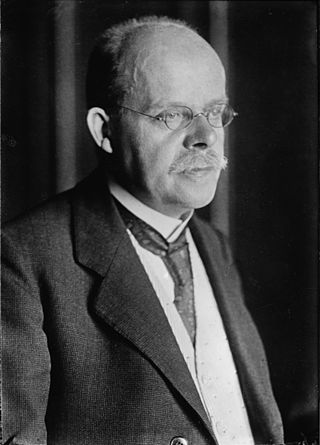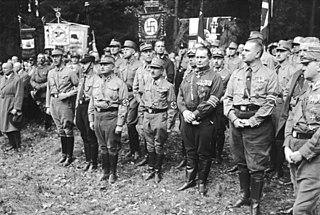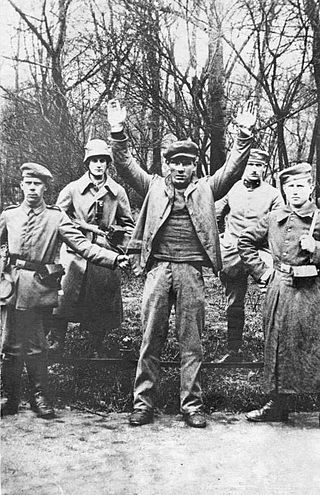
Freikorps were irregular German and other European military volunteer units, or paramilitary, that existed from the 18th to the early 20th centuries. They effectively fought as mercenaries or private military companies, regardless of their own nationality. In German-speaking countries, the first so-called Freikorps were formed in the 18th century from native volunteers, enemy renegades, and deserters. These sometimes exotically equipped units served as infantry and cavalry ; sometimes in just company strength and sometimes in formations of up to several thousand strong. There were also various mixed formations or legions. The Prussian von Kleist Freikorps included infantry, jäger, dragoons and hussars. The French Volontaires de Saxe combined uhlans and dragoons.

The Weimar Republic, officially known as the German Reich, was a historical period of Germany from 9 November 1918 to 23 March 1933, during which it was a constitutional federal republic for the first time in history; hence it is also referred to, and unofficially proclaimed itself, as the German Republic. The period's informal name is derived from the city of Weimar, which hosted the constituent assembly that established its government. In English, the republic was usually simply called "Germany", with "Weimar Republic" not commonly used until the 1930s.

The Night of the Long Knives, also called the Röhm purge or Operation Hummingbird, was a purge that took place in Nazi Germany from 30 June to 2 July 1934. Chancellor Adolf Hitler, urged on by Hermann Göring and Heinrich Himmler, ordered a series of political extrajudicial executions intended to consolidate his power and alleviate the concerns of the German military about the role of Ernst Röhm and the Sturmabteilung (SA), the Nazis' paramilitary organization, known colloquially as "Brownshirts". Nazi propaganda presented the murders as a preventive measure against an alleged imminent coup by the SA under Röhm – the so-called Röhm Putsch.

The Kapp Putsch, also known as the Kapp–Lüttwitz Putsch, was an attempted coup against the German national government in Berlin on 13 March 1920. Named after its leaders Wolfgang Kapp and Walther von Lüttwitz, its goal was to undo the German Revolution of 1918–1919, overthrow the Weimar Republic, and establish an autocratic government in its place. It was supported by parts of the Reichswehr, as well as nationalist and monarchist factions.

The Ruhr Red Army was an army of between 50,000 and 80,000 left-wing workers who conducted what was known as the Ruhr Uprising (Ruhraufstand), in the Weimar Republic. It was the largest armed workers' uprising in the nation's history, and ran from 13 March to 2 April, 1920, in Germany's most important industrial area. The workers were reacting to the Kapp Putsch, an effort by right-wing forces in March 1920 to overthrow the elected government.

Reichswehr was the official name of the German armed forces during the Weimar Republic and the first years of the Third Reich. After Germany was defeated in World War I, the Imperial German Army was dissolved in order to be reshaped into a peacetime army. From it a provisional Reichswehr was formed in March 1919. Under the terms of the Treaty of Versailles, the rebuilt German Army was subject to severe limitations in size, structure and armament. The official formation of the Reichswehr took place on 1 January 1921 after the limitations had been met. The German armed forces kept the name Reichswehr until Adolf Hitler's 1935 proclamation of the "restoration of military sovereignty", at which point it became part of the new Wehrmacht.

Der Stahlhelm, Bund der Frontsoldaten, commonly known as Der Stahlhelm, was a German First World War veteran's organisation existing from 1918 to 1935. In the late days of the Weimar Republic, it was closely affiliated to the monarchist German National People's Party (DNVP), placed at party gatherings in the position of armed security guards.

Kurt Ferdinand Friedrich Hermann von Schleicher was a German general and the penultimate chancellor of Germany during the Weimar Republic. A rival for power with Adolf Hitler, Schleicher was murdered by Hitler's SS during the Night of the Long Knives in 1934.

Wilhelm Marx was a German judge, politician and member of the Catholic Centre Party. During the Weimar Republic he was the chancellor of Germany twice, from 1923–1925 and 1926–1928, and served briefly as the minister president of Prussia in 1925. With a total of 3 years and 73 days, he was the longest-serving chancellor during the Weimar Republic.

Gustav Noske was a German politician of the Social Democratic Party (SPD). He served as the first Minister of Defence (Reichswehrminister) of the Weimar Republic between 1919 and 1920. Noske was known for using army and paramilitary forces to suppress the socialist/communist uprisings of 1919.
Paramilitary groups were formed throughout the Weimar Republic in the wake of Imperial Germany's defeat in World War I and the ensuing German Revolution. Some were created by political parties to help in recruiting, discipline and in preparation for seizing power. Some were created before World War I. Others were formed by individuals after the war and were called "Freikorps". The party affiliated groups and others were all outside government control, but the Freikorps units were under government control, supply and pay.
The early timeline of Nazism begins with its origins and continues until Hitler's rise to power.

Presidential elections were held in Germany on 13 March 1932, with a runoff on 10 April. Independent incumbent Paul von Hindenburg won a second seven-year term against Adolf Hitler of the Nazi Party (NSDAP). Communist Party (KPD) leader Ernst Thälmann also ran and received more than ten percent of the vote in the runoff. Theodor Duesterberg, the deputy leader of the World War I veterans' organization Der Stahlhelm, ran in the first round but dropped out of the runoff. This was the second and final direct election to the office of President of the Reich, Germany's head of state under the Weimar Republic.

The Harzburg Front was a short-lived radical right-wing, anti-democratic political alliance in Weimar Germany, formed in 1931 as an attempt to present a unified opposition to the government of Chancellor Heinrich Brüning. It was a coalition of the national conservative German National People's Party (DNVP) under millionaire press-baron Alfred Hugenberg with Adolf Hitler's National Socialist German Workers' Party (NSDAP), the leadership of Der Stahlhelm paramilitary veterans' association, the Agricultural League and the Pan-German League organizations.
The Black Reichswehr was the unofficial name for the extra-legal paramilitary formation that was secretly a part of the German military (Reichswehr) during the early years of the Weimar Republic. It was formed in 1921 after the government banned the Freikorps that it had relied on until then to supplement the Reichswehr. General Hans von Seeckt thought that the Reichswehr no longer had enough men available to guard the country's borders, but the army could not be expanded because of the manpower restrictions imposed on it by the Treaty of Versailles. In order to circumvent the limitation, Seeckt created the Black Reichswehr as purportedly civilian "labour battalions" attached to regular Reichswehr units. The Arbeitskommandos received military training, provisioning and orders from the Reichswehr, although ultimately they were never involved in military action. The Black Reichswehr reached a peak membership estimated at 50,000 to 80,000 in 1923 and was dissolved the same year after a group of its members launched the failed Küstrin Putsch. Its existence became widely known in 1925 when its practice of Fememord, the extra-judicial killing of "traitors" among its ranks, was revealed to the public.

Carl Wilhelm Severing was a German union organizer and Social Democratic politician during the German Empire, Weimar Republic and the early post-World War II years in West Germany. He served as a Reichstag member and as interior minister in both Prussia and at the Reich level where he fought against the rise of extremism on both the left and the right. He remained in Germany during the Third Reich but had only minimal influence on reshaping the Social Democratic Party after World War II.

Germany saw significant political violence from the fall of the Empire and the rise of the Republic through the German Revolution of 1918–1919, until the rise of the Nazi Party to power with 1933 elections and the proclamation of the Enabling Act of 1933 that fully broke down all opposition. The violence was characterised by assassinations by and confrontations between right-wing groups such as the Freikorps, and left-wing organisations such as the Communist Party of Germany.
The Fememurders were a series of murders in the Weimar Republic between 1919 and 1923 carried out by German far-right groups against individuals they believed had committed treason against them by betraying their secrets. They were considered a distinct category from politically motivated assassinations of public officials. By the time the Feme murders ended, they had claimed almost 400 victims. In spite of a number of investigations, few of the perpetrators were ever identified or prosecuted.
The Einwohnerwehr, or "Citizens' Defense," also called the Civil Guard or Civil Defense, was a far-right paramilitary in Weimar Germany that existed in violation of the Treaty of Versailles from the German Revolution of 1918-19 until 29 June 1921. It was established with the goal of defending Germany against Communist uprisings and foreign attacks, though it was also hostile to the Weimar Republic. It was based in Bavaria, where anti-Berlin and anti-republican sentiment attracted such activity. On 29 June 1921 the German government gave in to Allied demands and dissolved the Citizens' Defense. Its militants moved on to fight in other far-right paramilitaries with similar goals.

The Flag of the German Empire, or Imperial Flag, Realm Flag, is a combination between the flag of Prussia and the flag of the Hanseatic League. Starting as the national flag of the North German Confederation, it would go on to be commonly used officially and unofficially under the nation-state of the German Reich, which existed from 1871 to 1945.